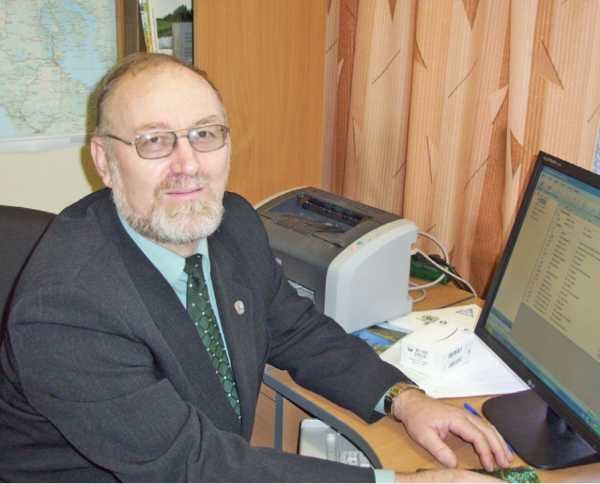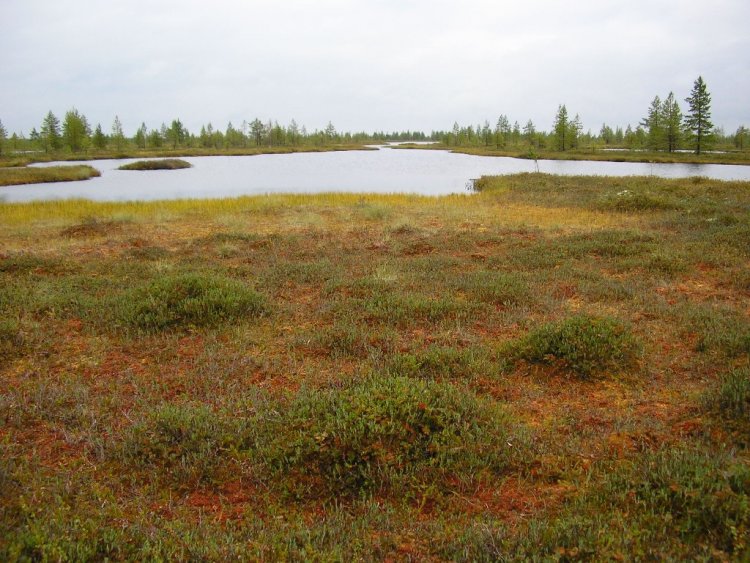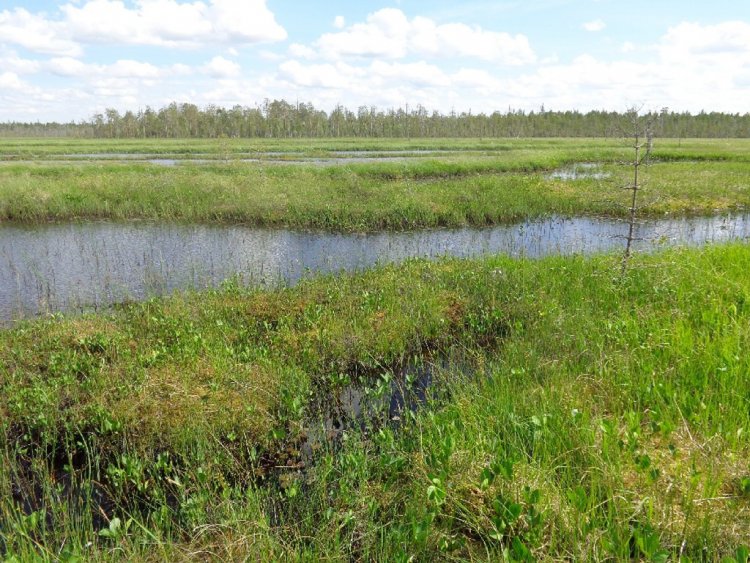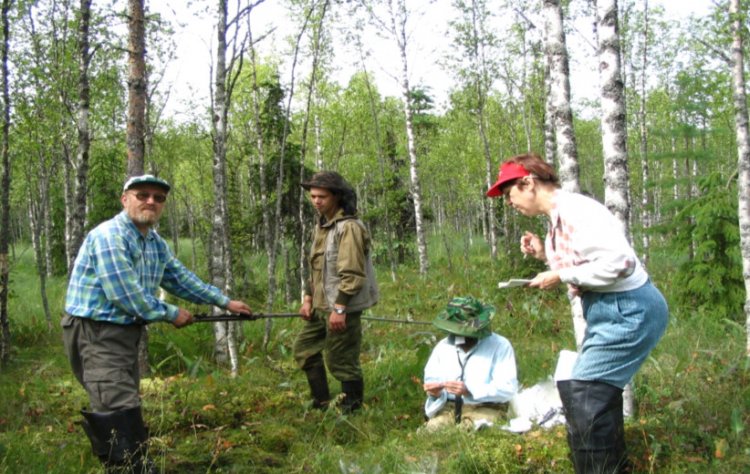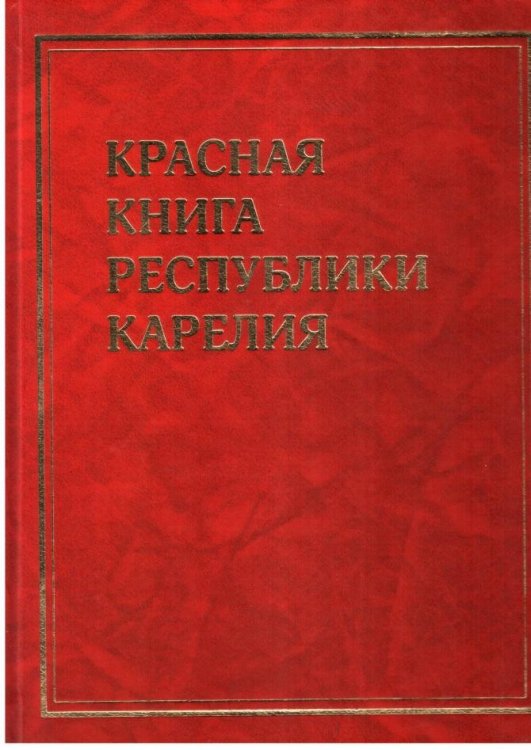Specialists of the Mire Ecosystems Laboratory at the Institute of Biology of the Karelian Research Center of RAS (Karelian Research Center of RAS, Petrozavodsk), which celebrates its 70th anniversary this year, follow the research traditions established by the Karelian scientific school of mire science. Complex long-term work of the Russian scientists on the study of mire ecosystems contributes to the preservation of the biosphere regulating the role of mires, their diversity in the Republic of Karelia and other boreal regions of Russia and occupies its rightful place in the domestic and world science according to the level of achievements of mire science and geobotany.
Mires as unique components of natural landscapes are characteristic of taiga regions, where they function to maintain water levels in adjacent biocenoses, form unique plant communities and serve as habitats for a number of animals. Previously, mires were drained and widely used in forestry and agriculture; they were also used for harvesting peat, used as an energy carrier. Today the mires remain a source of berries and medicinal plants and are even becoming an object of nature tourism, providing an opportunity to observe endangered animals and birds inhabiting the mires.
The team of mire scientists of the Karelian Research Center of the Russian Academy of Sciences (Petrozavodsk) has been studying peat deposits and resources of boreal regions of our country for many years; they also carry out the evaluation of the peat fund, which is necessary for further rational use of natural mires. The specialists also closely monitor the current state, development patterns and dynamics of plant communities of mire ecosystems, evaluate the diversity of rare species in order to control their population. In addition, experts carry out studies of mire stratigraphy and palaeogeographical works, making it possible to perform the reconstruction of paleo-vegetation in Holocene and create various thematic maps. Scientists pay great attention to the problem of preserving the diversity of ecosystems in the region and the creation of protected natural areas.
Oleg Leonidovich Kuznetsov
Doctor of Biological Sciences, Institute of Biology, KarRC RAS (Petrozavodsk)
Oleg Leonidovich Kuznetsov – Doctor of Biological Sciences, Honored Scientist of the Russian Federation, Chief Researcher of the Mire Ecosystems Laboratory at the Institute of Biology of KarRC RAS; Chief Researcher of the Analytical Expert Group of the Department of Multidisciplinary Scientific Research of KarRC RAS; Chief Researcher in the Laboratory for Ecological Monitoring and Modeling Department of Multidisciplinary Scientific Research KarRC RAS (Petrozavodsk) – described the formation of the Karelian School of Mire Science and his path to science, and told about the ecosystem and ecological functions of mires, the specifics of mire ecosystems and flora in Karelia, and the changes in the species composition of protected flora and fauna of Karelia in the new edition of his Red Book of the Republic of Karelia, published at the end of 2020.
This year Professor Oleg Leonidovich Kuznetsov celebrated his 50th anniversary of scientific activity.
Karelian scientist, a specialist in studying the regularities of the structure and dynamics of mire ecosystems of Eastern Fennoscandia, has developed a topological and ecological classification of mire vegetation, a typology of boglands of European Russia and has identified the specific features of the dynamics of the main types of mires in Karelia. He pays great attention to scientific grounds for the preservation of the region’s biodiversity and creation of specially protected areas of various ranks. He has been working at the Institute of Biology of the Karelian Research Center of the Russian Academy of Sciences since 1971 and for 30 years (from 1988 to 2018) he was the head of the Mire Ecosystems Laboratory. While he was a first-year student at Petrozavodsk State University, after his first expedition, Oleg Kuznetsov chose mire science as the area for his scientific research; the range of his research includes the study of flora, genesis, and the origin of mires. Because, as the Karelian scientist noted, “mire ecosystems are a complex of scientific research areas. We study vegetation, peat deposits, peat composition, history of mire formation, and the way they evolve. Mires are 90 percent water. In terms of jurisdiction, mires are under the jurisdiction of several departments: peat resources – geology, vegetation – botany, water bodies – hydrology.”
It is noteworthy that year 2021 also marks the 70th anniversary of the establishment of the Karelian School of Mire Scientists. In 1946, the Karelian-Finnish base of the USSR Academy of Sciences was founded; in 1950, the sector of mire science and melioration was included in the Karelian-Finnish base, which was transferred to the Institute of Biology in 1953. In 1961, the sector was transformed into the Mire Science Laboratory, and in 1988, it became the Mire Ecosystems Laboratory that has been successfully functioning up to this day.
“We are considered (and recognized in the world scientific community) today as the leading scientific school of mire science in the system of the Academy of Sciences, which conducts multidimensional research on mire ecosystems. We still maintain continuity and multidisciplinarity: flora and vegetation, dynamics, mire stratigraphy, spore-pollen analysis, classical botanical analysis of peat. In many regions, peat analysts and mire specialists have almost disappeared. Geobotanical and typological areas remain our main focus, but there are some applied aspects, too (for example, monitoring the productivity of berry plants, anthropogenic transformation of bogs after melioration (although not to the same extent as it was in the 80-90s in the Soviet times)),” Doctor of Biological Sciences Oleg Kuznetsov says.
One of the first sectors of the Institute was that of mire science and melioration, because mires occupy 30% of land in Karelia and peat was the most important energy resource for many of the largest power plants in Leningrad Oblast and Moscow region. Therefore, one of the new laboratory’s tasks was to study peat and peat fund. In order to fulfill these research goals, Leon Yakovlevich Lepin, a prominent mire and peat scientist, and Ekaterina Alekseevna Galkina, an outstanding mire scientist, geobotanist, laureate of the State Prize (for development of a method of aerial photo decoding for military equipment passability in mires), came to Karelia. They trained the first generation of postgraduate students, who grew into the future mire scientists of the Karelian scientific school. The 50s of the 20th century are considered decisive for the formation of the Karelian School of Mire Science.
Later, Valentin Danilovich Lopatin, a major geobotanist and mire scientist, Doctor of Biological Sciences, who was the head of the Mire Science Laboratory from 1960 to 1968, and then worked successfully there until 1987, came to Karelia. Under his leadership, the Laboratory staff developed the Map of Vegetation of Karelian Mires, prepared and defended 5 candidate dissertations.
In 1967, Karelian Branch of the USSR Academy of Sciences was restored and Nikolai Ivanovich Pyavchenko, a corresponding member of the USSR Academy of Sciences, the country’s leading mire researcher, the founder of the new scientific direction – forest bog science, a theorist and supporter of wise forest melioration, was appointed Chairman of the Presidium. In 1968-1973, he was the head of the Mire Science Laboratory at the Karelian-Finnish Institute of Biology, and Oleg Kuznetsov was a student and graduate student of N. I. Pyavchenko.
During the early years of the mire science formation, Tatiana Kornelievna Yurkovskaya, a graduate of Leningrad State University, a leading Russian mire scientist and geobotanist-cartographer, who had worked there for many years, came to work in the Karelian-Finnish base of the USSR Academy of Sciences. A specialist in the typology of the Russian mires, she was the first to establish the distribution of typical for the northern taiga string mires throughout the boreal zone of European Russia; she is the author and co-author of many vegetation maps of our country, as well as Europe and the world. Doctor of Biological Sciences T. K. Yurkovskaya is still an active researcher at the Komarov Botanical Institute of the Russian Academy of Sciences and is involved in the training of scientific personnel.
Galina Andreevna Elina was a student of Lopatin and a follower of Yurkovskaya; she dealt both with general problems of mire science and with palaeogeographical studies of Late Glacial and Holocene vegetation dynamics in Eastern Fennoscandia and now her research is widely known in the whole world. Doctor of Biological Sciences G.A. Elina was the head of the Laboratory of Mire Ecosystems in 1973-1988.
“Our laboratory was the home of a galaxy of leading Russian mire scientists,” Oleg Kuznetsov emphasized.
At present, the scientific traditions are continued by young specialists who work at the Laboratory of Mire Ecosystems at the Karelian Research Center of the Russian Academy of Sciences. Under the scientific leadership of Oleg Kuznetsov, five candidates of science and one doctor of science have successfully defended their theses, and two more graduate students are now finishing their dissertations.
Some editions are devoted to the issues of mire science. These books include publications by Oleg Kuznetsov along with authors from many countries
Why is the study of the structure and dynamics of mire ecosystems and their diversity still relevant today?
“The unique function of mires on Earth as a whole is that they accumulate peat (part of undecomposed plants). Besides nitrogen, some carbon is released from the cycle in this peat for thousands of years. In other words, mires are a unique system for regulating the composition of the atmosphere and the carbon balance. Therefore, the issues of natural mire ecosystem carbon cycling remain relevant today, and, according to many expert estimates, the natural ecosystem function of mires is more valuable than burning peat or draining mires, after which peat accumulation stops. This biosphere function of bogs is very important in a warming climate.
We are used to taiga bogs. In tundra and forest tundra vast areas are occupied by frozen bogs (bumpy and polygonal) – they are trapped by permafrost. These frozen bogs are now beginning to thaw massively, decomposing organic matter and releasing methane. Today, Russia has 40% of the peat resources, we are the boggiest country.
The hydrological role of bogs remains important. A number of environmental problems have arisen in the areas with mass melioration. Europe has been spending a lot of money on the restoration of previously disturbed bogs since the 80s. The cultivation of bogs and even sphagnum mosses has begun, a new direction in economic activity – bog farming – has emerged. Preservation of natural bogs in a certain region is an important task.
A bog is a resource component. In a number of countries, peat remains an energy raw material. For example, in Finland, there are large peat mines and peat is widely used in the energy sector. Although there are disputes between environmentalists and economists as to whether peat is a renewable resource or not. In addition, many countries consider peat to be the best substrate for greenhouses. Ireland exhausted its peat resources and they import it from the Baltic countries (there are many bogs and there are ports for its transportation). Russia could also become a potential source of peat resource. There are estimates that once the peatlands are developed in reasonable proportions, it is possible to restore the resource. There is a lot of work on the use and innovation of peat deposits. The regional energy industry does not use sawdust capsules and briquettes only. After chemical processing, peat can serve as a raw material for the production of many substances and materials.
Mire is a source of various resources. For example, wild mushrooms and berries (cranberry, cloudberry, blueberry). We conduct work on the selection and cultivation of cranberries in our country at the Kostroma Forest Experimental Station and in the Botanical Garden of Novosibirsk.
Mire is a recreational and hunting site, an animal habitat. National parks now have trails and wooden bridges. After all, mires are also the habitat of birds, so they build special towers to observe birds with binoculars. This is a very promising area of tourism. It is being gradually introduced in Karelia, practiced in the Kostomuksha State Reserve (part of the Russian-Finnish reserve “Druzhba”), in the Paanajärvi National Park. Mires are attractive for different types of nature tourism,” Oleg Kuznetsov said.
What is the specificity of mire ecosystems of the Republic of Karelia? What are the types of mires and which of them are represented in Karelia?
“Karelia is a territory with a cool humid climate and a dissected relief. The area was freed from the glacier 11-12 thousand years ago and when the glacier was gone, it left tens of thousands of depressions that were filled with water and then began to turn into marshes. Therefore, mires in Karelia occupy 30% of the territory. Due to the fact that the landscape in Karelia is very diverse, the type of mires is also diverse. These are mossy raised mires and transitional mires, as well as lowland grassy mires. For example, high bogs are fed by atmospheric precipitation and characterized by shrubs and stunted pine along with a continuous sphagnum cover. There are 1.5 million of such bogs in Karelia, but they are also different.
Our reservoirs changed after the glacier spread and changed their level. On the shore of the White Sea, you can trace 3-4 terraces as the sea recedes and the territory elevates.
The territory of Karelia is still constantly elevating. It is an isostatic elevation. Terraces of the White Sea formed raised bogs of different ages and at different stages: they are 9-10 thousand years old on the highest ones, 7-8 thousand years old on the next ones, and 5-6 thousand years old on the last ones. On the highest ones, there are big ridgy-lacustrine bogs 4-6 meters deep (see photo below).
High ridge-lacustrine bog on the Pribelomorsky lowland (Belomorsky region of the Republic of Karelia), September 2005.
The White Sea lowland is swamped by 60-80%. It is a massive peat basin. The central part of Karelia is a ridge terrain, directed from north-west to south-east. Bogs are confined to lowerings, they are stretched in narrow chains and join into complex systems. Northern bogs – strain bogs – prevail here; they are concave, richer in mineral composition and occupy almost one million hectares in the northern and middle part of Karelia (see photo below).
Strain bog with a typical ridge-soil complex in Vodlozersky National Park (Arkhangelsk region).
July 2017.
There are also small lowland grassy bogs in Karelia. They are riverside and lakeside, which means they are flooded by water in spring.
Karelia is the eastern part of the Scandinavian Shield, which is the reason for this relief. Hence the peat deposits of mires are from 1-2 to 7 meters there. If a mire was formed on the site of a lake, it has lake silt (sapropel) at the bottom. The share of mires of lake origin is quite high, many mires originated from lakes. Mostly, we have mire systems, because individual mires became fused with each other as they expanded. Such systems also include residual lakes.
The geology diversity gives peculiarity to all Karelia mires. The specificity lies in the systemic character and the preservation of lake share. In addition, the native Karelian rocks of soils are rather poor and acidic. We do not have so many classic lowland bogs, similar to those found in central Russia. We only have lowland bogs with rich and peculiar flora and vegetation in the places of marble and dolomite outcrops. They are small and require preservation,” Oleg Kuznetsov explained.
How to move through mires correctly and safely?
“Mires are passable in most places. You have to walk through the mire gently, not smashing, leaning on a stick. But floodplain mires are not very comfortable and you can sink into them,” the Karelian the mire specialist advised.
What kind of mire should you be more careful in?
“If a mire has a key spring and a carpet of moss on top, you can get sucked in, or if there was a stream in a mire and now there is a sphagnum carpet, but no tier of grasses (sedge, fritillary, cinquefoil). The mire can also be dangerous if there is bare moss without grass on the floating mires,” Oleg Kuznetsov explained.
A cotton-grass sphagnum bog in the Pasvik Nature Reserve (Murmansk region). It has a continuous cover of Lindberg’s sphagnum, the main species of mosses in the northern upland bogs. August 2013.
What is the peculiarity of the flora of Karelian bogs?
“The flora of Karelia is not specific because it is young and migratory. So, they are plants-immigrants from other regions. The only specificity is that many species are on the border of their habitats. For example, some boreal species came from Siberia, but have not penetrated into the territory of Finland. Atlantic species came to Karelia, but at the same time they are not found in either Vologda or Arkhangelsk Regions. Therefore, the laboratory regularly hosts international symposiums and Finnish scientists and students often come to us for botanical and geographical excursions, so that they can see the specifics of Karelian nature. In addition, the Karelian flora has a high degree of preservation. Though during the Soviet times, we conducted melioration, we didn’t spoil as much mires (not all the mires are drained) as Finland,” the scientist says.
Peat sampling for botanical analysis at the Uchebnoye bog (Pryazhinsky district, Republic of Karelia).
From left to right: O. L. Kuznetsov, S. A. Kutenkov, S. I. Grabovik, T. I. Brazovskaya. July 2004
A new edition of the Red Book of the Republic of Karelia, prepared by specialists of the Karelian Research Center of the Russian Academy of Sciences, was published this year. The Red Data Book is a juridical document, published every 10 years (in this case the time interval was 13 years), and now its publication was timed to coincide with the 100th anniversary of the Republic of Karelia. Oleg Kuznetsov acted as editor-in-chief of the new edition of the Red Data Book and author of a number of articles (essays) on vascular plants.
The new edition of the Red Book of the Republic of Karelia, released in 2020 and timed to coincide with the 100th anniversary of the Republic of Karelia
The researcher from Karelia indicated the number of plant species and subspecies in need of protection that were included in the new edition for the first time and whether there were species that were replaced/excluded from the main list:
“Compared to the previous Red Book, the lists of protected species have changed significantly, with 774 plant and animal species now listed. We have re-evaluated the status of species and therefore 228 species have been removed from the previous list of endangered species and 121 new species have been included in it. Most of the excluded species are not in great danger of decline and extinction in the republic, so they are included in the List of species in need of special attention (biological surveillance), which includes 143 species. They include such species of plants as Siberian larch, Hierochloe australis, Baltic rush, Perforate St John’s-wort, and birds such as great cormorant, short-eared owl, and Eurasian skylark. There are some bog plant species among those excluded, which are not threatened with extinction due to the cessation of bog drainage.
The newly included species are native species found in the country in the last 15 years, with vascular plants such as Drymochloa sylvatica, Obtuse sedge, as well as a significant number of insects, several species of mosses, lichens, and mushrooms. The list of protected birds has grown significantly, the threat to the state of their populations has increased due to their deaths in places of wintering and during migration, as well as poaching. These are the black-throated loon, gray goose, whooper swan, gray duck, willow ptarmigan, etc.”
How can one generally characterize the current state of unique species populations in the region and their dynamics, based on the materials from the Red Book of the Republic of Karelia?
“We downgraded the category of rarity status for many species, as the information on them is rather old, so they are categorized as 4 – “insufficient data,” in the future, with the appearance of a modern assessment of their status, their category can be changed. There is no real threat of extinction for most of the species included in the Red Book of the Republic of Karelia. However, not all of them are represented in the protected areas of the Republic,” the scientist of KarRC RAS clarified.
What is being done to organize protection of mires at present?
“The issues of mass mire melioration are no longer relevant today. At present, the main problem is deforestation that affects hydrology. In taiga conditions, it is clear-cutting. If an area is subject to protection, this protective status must be respected. And if the mire is spoiled and not functioning, then some of these mires can be used for peat harvesting to replace fuel oil. The mire use for the purposes of nature tourism will not harm the ecosystem preservation, since there is no big load here. But there is a lot of inconsistency in the legislation on protected natural areas. For example, if we are planning to develop different types of tourism in this area, it is necessary to change the nature reserve status to the national park status. Besides, very few tourists will go to an undeveloped mire,” Oleg Kuznetsov said.
Recently Karelian bog scientists have been actively working in Murmansk Region in the Pasvik state nature reserve on the border with Norway, in Arkhangelsk Region, in the central part of the Kola Peninsula in the Ponoy River valley (it is planned to change the reserve status here and there are many boggy territories, so the staff of the KarRC RAS is invited as experts).
It is planned to hold a conference titled “Bogs of Northern Europe” with the participation of colleagues from Scandinavia and other countries next year. The specificity of such events lies not only in getting to know the achievements of colleagues – bog scientists, but also in natural tours. According to Oleg Kuznetsov, “the most interesting way of communication during such conferences is to see the objects.” The book Mires and Peatlands of Europe, compiled by 134 mire specialists, was published in 2017; it is unique in providing a mire overview of the European region as a whole and for each European country. Oleg Kuznetsov was an author of the chapter on the mires of the European part of Russia included in this multiyear publication.
On Wetlands Day (February 2), the Section of Wetland Studies of the Russian Botanical Society and the Botanical Institute of the Russian Academy of Sciences used to periodically host Galkin Readings, which evolved into a conference format over time. This year, on April 21, the Komarov Botanical Institute of the Russian Academy of Sciences and the Russian Botanical Society are holding an all-Russian conference with international participation “11th GALKIN READINGS.” The readings are timed to coincide with the 50th anniversary since the publication of N. Ya. Katz’s book The Globe Mires. We plan to discuss what has changed in the study of mires in Russia since the publication of this monograph. Oleg Kuznetsov will make a report, in which he will present an overview of the modern typology and zoning of Fennoscandia mires.
Thus, theoretical developments, field observations and methodology of the complex study of mires at the intersection of botany, geology, soil science, hydrology, paleogeography, carried out by staff of the Institute of Biology, Russian Academy of Sciences, make it possible to cover a wide research range and remain in demand in the world community. Proposals put forward by Karelian scientists on the study and conservation of mire ecosystems of Karelia contribute to their integrity and diversity.
